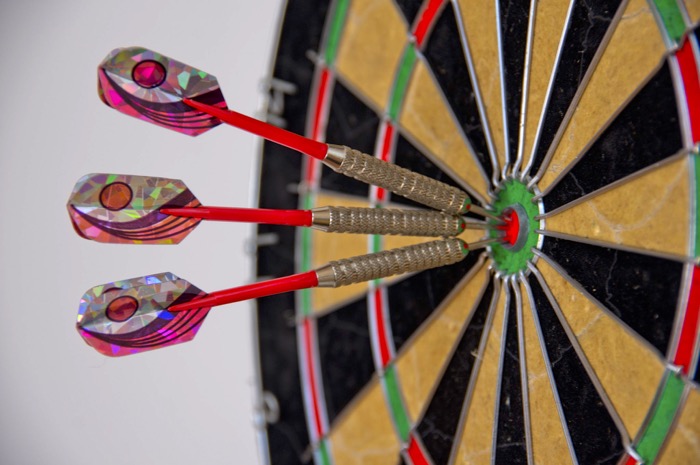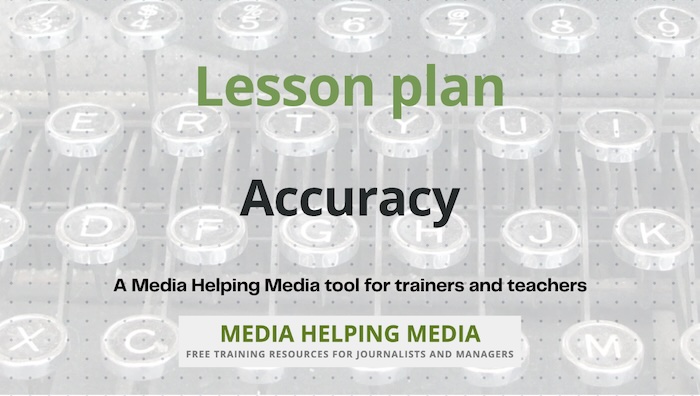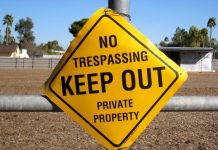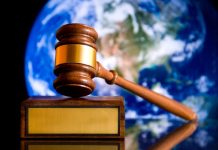
News journalism is about the assembly and publication or broadcast of information which has been thoroughly checked to ensure it is factual and accurate.
That information must be supported by strong evidence, and it must be clear and unambiguous. There can be no room for mistakes or misunderstanding.
A news journalist’s job is to uncover facts that can be verified and attributed to trusted sources. They should not deal in rumour or speculation. Nor should they add their own opinions or feelings when they are compiling their news reports. Accuracy is an essential part of that process.
Accuracy comes ahead of speed. If you are not sure, then don’t publish until you are. Being first and wrong is not a model to aim for. Being right and always reliable is.
Journalists need to be totally transparent in declaring what they know and what they don’t know. Those who trust you and your news organisation will be prepared to wait for your version. In fact they might use your version of events to check whether a hastily prepared item by another news organisation has any truth in it.
Most major news organisations require their journalists to:
- have first-hand sources, not just talk to the same people as everyone else
- double-check all the facts that appear in their news reports include supporting evidence or sources
- validate the information submitted
- confirm that something has happened by having two reliable and independent sources
- include corroboration for any claims or allegations made.
Journalism involves research. A reporter working on a story might need to read archived news stories to find out more about the background to an event. But they can’t afford to copy what they see. The words might look convincing, but that doesn’t make them true.
Unless you know for certain that what you are reading is an accurate record of what has happened you should not refer to it. Even archive material must be treated with the same scepticism as is applied to a current news story.
Nothing must be included until it has been verified. If you are forced to include material that you have been unable to check yourself you must qualify that information by attributing it to a source. In such cases you would use words such as “according to” so that those consuming your news are not left believing that you are saying it is true. It is also worth adding that you have not been able to verify the information given, if that is the case.
Keeping notes and records
Most reporters are given a notebook when they start work for the first time and told to keep it safe and never throw it away. This is because you never know when you might have to refer to your notes as evidence in a legal case.
Accurate note-taking is essential. The usual rule is that notes must not only be accurate, they must also be contemporaneous. That means that you need to have spoken to reliable sources at the time an incident happened rather than jot down information from memory at a later date.
You will also need to keep records of the research you carried out for your report. All this information should all be contained in your notebook, or, in the case of those using computers, in folders and files. And always keep a track of all bookmarks and email correspondence relating to your stories.
However, where anonymity has been requested or where it is essential, make sure that your records do not identify those you have interviewed.
Names, numbers, and dates
Accuracy is essential when you are dealing with names, numbers, and dates. You must get the spelling of a person’s name right if you are to refer to them in the story. If you are referring to their age, this has to be right, too. If you are writing about the number of people attending a meeting you should not guess, but you should seek out someone who might know, such as the event organiser, and quote them.
If you are writing about an incident that has occurred you must get the day and date right, as well as the street name where it happened. This is not just a matter of being accurate, it’s also a matter of being legally safe. If a reporter produces a story with a misspelt name of someone living at the wrong address who is said to have been involved in an incident on the wrong day, this could be a legal minefield for the reporter and the news organisation they work for.
Fake news and social media
Accuracy is also important because of the growth in fake news. The speed at which fake news can spread has been increased by the growth in social media – and the dependency of many in the audience on outlets such as Twitter and Facebook for their primary source of news.
The danger of sharing news on social media is the separation of the original source from the ongoing conversation. Facebook is structured so that the more people add their comments, the more distant the original content – factual or fake – becomes from the post being discussed.
Someone might post a valid link to a news story on a trusted news site which is a piece of fact-checked, accurate, fair, objective, and impartial reporting. But what they post as a response is their personal emotional reaction. Then someone else sees that comment and posts their reaction. As they do they might add an anecdote or a piece of gossip. Then someone else comments. And as the comment thread grows longer and longer, the reader is getting further and further from the original source.
And the same is true with Twitter. The longer the thread of comments – many based on an emotional reaction to the previous post and not the original post – the further we get from the original material. That could be a good thing if the original post was fake and contained information that needed to be challenged. But it can be dangerous when the original post was factual and subsequent posts have not challenged those facts with reason, sound evidence and fact-checked information, but have drowned out sensible debate by injecting falsehood.
Unlike the journalist who wrote the original piece, those commenting on social media are rarely bound by editorial ethics – least of all accuracy. This phenomenon is called post-truth – which means the conversation that happens after the information has been published and which is based on emotional reaction rather than factual information. And this is a danger for journalists who are monitoring social media feeds.
Most newsrooms have specialist journalists who monitor the social media feeds. Their job is to find news stories on social media but not to feed off the fake news that is being spread. Many newsrooms have fact-checking departments whose job it is to scrutinise all information being shared on social media or directly by those in power. Many independent fact-checking news sites have sprung up in the last five years. Their job is to ensure accuracy.
Protecting sources
A journalist will often have to turn to anonymous sources as part of their news-gathering. It might be the case that part of the fact-checking process is to find and talk to people who are afraid of being identified for safety or career reasons. If you feel that the information these people have is crucial to the accuracy of your report, and if you can’t find the corroboration to complete the story elsewhere, you might have to agree to anonymity.
If you are considering offering anonymity to an interviewee you must make sure that your editor agrees. There may be reasons that anonymity is not appropriate; this should be a decision for your editor, not you. Including your editor in this process will also help protect you and your sources in the long run.
Anonymity raises some ethical issues about misleading the public. You might agree to any of the following to disguise identity:
- using a voice-over to broadcast what they say
- using blurred images so as not to identify the individuals
- hiding locations so that those seeking anonymity can’t be traced
- avoiding using real names and not giving an age range.
These are fine as long as you make it clear that you are using such techniques, and state clearly why you are using them. You must not use any methods that could be seen as a false representation of the truth.
If you are dealing with an anonymous source who is making serious allegations, you will need to decide whether:
- the story is of significant public interest
- the source is credible and reliable
- the source is likely to be in a position to offer accurate information
- there are any legal issues
- anyone’s safety could be at risk
- a response to the allegations can be found.
If you agree to go ahead with the interview, then you need to make clear to the user/audience/reader the conditions under which the material was gathered. You must never mislead the audience.
Reconstruction and archive material
If you can get by without staging a reconstruction, try to do so. Reconstructions can confuse the audience. If you do create a reconstruction, it needs to be as accurate as possible. If you are using archive material always make clear where it is from, when the archived event happened and the circumstances surrounding it. Never use archive material to represent a current event without labelling it as such. To neglect to do so would be inaccurate.
Misleading the audience
The concern over misleading the audience extends to some everyday journalistic practices that many in the profession consider to be normal. These mostly apply to broadcast journalism and include:
- rephrasing questions after the interview ends
- retrospectively including pictures of the interviewer nodding, smiling or frowning in response to answers given
- inserting general shots of items in the room, or hand movements to cover edits made in the interview
- set-up shots of the interviewee and interviewer which are used to lead into the interview
All these can be fairly innocent editing techniques used by broadcast media to make a long and sometimes boring interview more digestible, however they can also mislead. Be careful how you use them and try to avoid them.
Third-party material
Always make clear when material has been provided by others. Attribution is essential. Say “according to…” or “it’s being reported by…” and you are covered. However, in contentious issues, your sources need to be representative of the widest opinion base in order to protect your credibility. Sourcing such information is part of your commitment to accuracy.
At times you will want to build a report around statistics. Sometimes those statistics are offered to all news outlets via the wires (news agencies). In that case you must qualify them. Always make clear that there is a margin of error, particularly with trends. It is conceivable that business leaders, politicians and individuals with something to gain will feed you statistics to make their cause look good. They might present them in a way that doesn’t accurately reflect the true story. If you are unable to offer a full analysis of the statistics but feel you should use what you have been told, then you must attribute the information to the source and make clear that it is their view rather than fact.
Admitting mistakes
The willingness to admit mistakes is another part of being accurate. This has become all the more important in the age of online archives, although it has always been the case that mistakes in old newspaper cuttings could be repeated and result in an inaccurate report being circulated again years later. All news organisations should have a correction strategy.

Questions
- What is the primary role of a news journalist?
- Why is accuracy prioritised over speed in news journalism?
- Describe the importance of transparency in journalism.
- What are some of the requirements major news organisations have for their journalists?
- Explain the potential legal implications of inaccuracies in reporting names, numbers, and dates.
- How might social media contribute to the spread of fake news?
- What ethical considerations should journalists keep in mind when dealing with anonymous sources?
- Discuss the potential risks of using reconstructions and archive material in news reporting.
- How can everyday journalistic practices potentially mislead the audience?
- Why is it important for journalists to admit mistakes, especially in the digital age?
Answers
- The primary role of a news journalist is to uncover facts that can be verified and attributed to trusted sources in order to ensure that the information is factual and accurate.
- Accuracy is prioritised over speed to avoid publishing incorrect information; being first and wrong is not a desirable model.
- Transparency is important in journalism to maintain trust with the audience, as it involves declaring what is known and unknown.
- Major news organisations require journalists to have first-hand sources, double-check facts, include supporting evidence, validate information, and confirm events with reliable sources.
- Inaccuracies in reporting names, numbers, and dates can lead to legal issues, because they may misrepresent individuals or events, potentially causing harm.
- Social media can contribute to the spread of fake news by allowing emotional reactions and comments to distance the original factual content from the ongoing conversation.
- Ethical considerations include ensuring the source is credible, the story is in the public interest, and discussing anonymity with an editor to avoid misleading the public.
- Reconstructions and archive material can confuse the audience if not accurately represented or labeled, leading to potential misinformation.
- Rephrasing questions or using set-up shots can mislead the audience by altering the perception of the interview or event.
- Admitting mistakes is important for maintaining credibility and accuracy, especially with the permanence and accessibility of digital archives.
Lesson plan for trainers
If you are a trainer of journalists we have a free lesson plan: Accuracy in journalism which you are welcome to download and adapt for your own purposes.
Take a look at these other modules on Media Helping Media to help you keep your journalism up to the highest standards.









